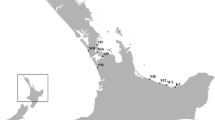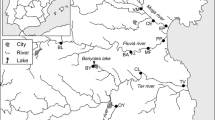Abstract
Understanding the introduction history and the impact of founder events on invasive species is crucial to understanding the evolutionary mechanisms driving successful invasions. Recently, there has been increased discussion of the “paradox” of invasions, the high success of introduced populations that presumably have limited genetic diversity associated with founder events. The western mosquitofish Gambusia affinis is an ideal species for evaluating this paradox, because it has been widely introduced from its native range in central Texas, USA. This species was introduced to the North Island of New Zealand, circa 1930, and has since invaded aquatic habitats across the North Island. We conducted a microsatellite assay of populations from both the native and introduced range to verify the documented history of invasion and to assess the impact of serial introduction events on the genetic diversity of recently established New Zealand populations. The molecular data were consistent with the documented introduction history. In addition, we found sharp reductions in the allelic richness and the heterozygosity of the introduced populations relative to the original native populations, indicating the presence of founder effects. We also observed the development of strong genetic structure within the introduced range, which is absent within the native range. Finally, we applied approximate Bayesian computation to the introduction scenario to estimate the long-term effective population sizes for the sampled populations.



Similar content being viewed by others
References
Allendorf FW, Lundquist LL (2003) Introduction: population biology, evolution, and control of invasive species. Conserv Biol 17:24–30
Alò D, Turner TF (2005) Effects of habitat fragmentation on effective population size in the endangered rio grande silvery minnow. Conserv Bio 19(4):1138–1148
Beaumont MA, Cornuet J-M, Marin J-M, Robert CP (2009) Adaptive approximate Bayesian computation. Biometrika 96:983–990
Bertorelle G, Benazzo A, Mona S (2010) ABC as a flexible framework to estimate demography over space and time: some cons, many pros. Mol Ecol 19:2609–2625
Brooks R, Endler JA (2001) Direct and indirect sexual selection and quantitative genetics of male traits in guppies (Poecilia reticulata). Evolution 55:1002–1015
Cavalli-Sforza LL (1967) Phylogenetic analysis: models and estimation procedures. Evolution 21:550–570
Chesser RK, Smith MW, Smith MH (1984) Biochemical genetics of mosquitofish III. Incidence and significance of multiple insemination. Genetica 64:77–81
Clegg SM, Degnan SM, Kikkawa J, Moritz C, Estoup A, Owens IPF (2002) Genetic consequences of sequential founder events by an island-colonizing bird. Proc Natl Acad Sci 99:8127–8132
Corander J, Waldmann P, Sillanpaa MJ (2003) Bayesian analysis of genetic differentiation between populations. Genetics 163:367–374
Corander J, Marttinen P, Siren J, Tang J (2008) Enhanced Bayesian modelling in BAPS software for learning genetic structures of populations. BMC Bioinform 9:539
Cornuet J-M, Santos F, Beaumont MA, Robert CP, Marin J-M, Balding DJ, Guillemaud T, Estoup A (2008) Inferring population history with DIY ABC: a user-friendly approach to approximate Bayesian computation. Bioinformatics 24:2713–2719
Csilléry K, Blum MGB, Gaggiotti OE, Francois O (2010) Approximate Bayesian computation (ABC) in practice. Trends Ecol Evol 25:410–418
Dlugosch KM, Parker IM (2008) Founding events in species invasions: genetic variation, adaptive evolution, and the role of multiple introductions. Mol Ecol 17:431–449
Estoup A, Guillemaud T (2010) Reconstructing routes of invasion using genetic data: why, how and so what? Mol Ecol 19(19):4113–4130
Felsenstein J (2004) PHYLIP. Department of Genome Sciences, University of Washington, Seattle
Frankham R (1998) Inbreeding and extinction: Island populations. Conserv Biol 12:665–675
Frankham R (2005) Stress and adaptation in conservation genetics. J Evol Biol 18:750–755
Fridley JD, Stachowicz JJ, Naeem S, Sax DF, Seabloom EW, Smith MD, Stohlgren TJ, Tilman D, Holle BV (2007) The invasion paradox: reconciling pattern and process in species invasions. Ecology 88:3–17
Gaither MR, Bowen BW, Toonen RJ, Planes S, Messmer V, Earle J, Ross Robertson D (2010) Genetic consequences of introducing allopatric lineages of Bluestriped Snapper (Lutjanus kasmira) to Hawaii. Mol Ecol 19:1107–1121
Garza JC, Williamson EG (2001) Detection of reduction in population size using data from microsatellite loci. Mol Ecol 10:305–318
Goudet J (1995) FSTAT (version 1.2): a computer program to calculate F-statistics. J Hered 86:485–486
Guillemaud T, Beaumont MA, Ciosi M, Cornuet JM, Estoup A (2009) Inferring introduction routes of invasive species using approximate Bayesian computation on microsatellite data. Heredity 104:88–99
Hedrick PW, Kalinowski ST (2000) Inbreeding depression in conservation biology. Annu Rev Ecol Syst 31:139–162
Johnson JA, Bellinger MR, Toepfer JE, Dunn P (2004) Temporal changes in allele frequencies and low effective population size in greater Prairie-chickens. Mol Ecol 13(9):2617–2630
Juliano R, Guerrero Iii R, Ronquillo I (1989) The introduction of exotic aquatic species in the Philippines. Exotic Aquatic Organisms in Asia. Asian Fisheries Society, pp 83–87
Kalinowski ST (2002) Evolutionary and statistical properties of three genetic distances. Mol Ecol 11:1263–1273
Keller SR, Taylor DR (2010) Genomic admixture increases fitness during a biological invasion. J Evol Biol 23:1720–1731
King S (1997) Sex ratio and developmental stability in Gambusia affinis affinis. University of Waikato, New Zealand
Kolbe JJ, Glor RE, Rodriguez Schettino L, Lara AC, Larson A, Losos JB (2004) Genetic variation increases during biological invasion by a Cuban lizard. Nature 431:177–181
Krumholz LA (1948) Reproduction in the Western Mosquitofish, Gambusia affinis affinis (Baird & Girard), and Its Use in Mosquito Control. Ecol Monogr 18:1
Lambert DM, King T, Shepherd LD, Livingston A, Anderson S, Craig JL (2005) Serial population bottlenecks and genetic variation: translocated populations of the New Zealand Saddleback (Philesturnus carunculatus rufusater). Conserv Genet 6:1–14
Latch E, Dharmarajan G, Glaubitz J, Rhodes O (2006) Relative performance of Bayesian clustering software for inferring population substructure and individual assignment at low levels of population differentiation. Conserv Genet 7:295–302
Leberg PL (1990) Influence of genetic variability on population growth: implications for conservation. J Fish Biol 37:193–195
Leberg PL (1992) Effects of population bottlenecks on genetic diversity as measured by allozyme electrophoresis. Evolution 46:477–494
Leberg PL (1993) Strategies for population reintroduction: effects of genetic variability on population growth and size. Conserv Biol 7:194–199
Lee CE (2002) Evolutionary genetics of invasive species. Trends Ecol Evol 17:386–391
Lindholm AK, Breden F, Alexander HJ, Chan WK, Thakurta SG, Brooks R (2005) Invasion success and genetic diversity of introduced populations of guppies Poecilia reticulata in Australia. Mol Ecol 14:3671–3682
Maruyama T, Fuerst PA (1985) Population bottlenecks and nonequilibrium models in population genetics. II. Number of alleles in a small population that was formed by a recent bottleneck. Genetics 111:675–689
McDowall RM (1984) Exotic fishes: the New Zealand experience. Distribution, Biology, and Management of Exotic Fishes. Johns Hopkins University Press, Baltimore, pp 200–214
McDowall RM (1990) New Zealand freshwater fishes: a natural history and guide. MAF Pub. Group
Nei M, Maruyama T, Chakraborty R (1975) The bottleneck effect and genetic variability in populations. Evolution 29:1–10
Oosterhout CV, Hutchinson WF, Wills DPM, Shipley P (2004) Micro-checker: software for identifying and correcting genotyping errors in microsatellite data. Mol Ecol Notes 4:535–538
Peakall R, Smouse PE (2006) Genalex 6: genetic analysis in excel. Population genetic software for teaching and research. Mol Ecol Notes 6:288–295
Purcell KM, Lance SL, Jones KL, Stockwell CA (2011) Ten novel microsatellite markers for the western mosquitofish Gambusia affinis. Conserv Genet Resour 3:361–363
Pyke G (2005) A review of the biology of Gambusia affinis and G. holbrooki. Rev Fish Biol Fish 15:339–365
Pyke GH (2008) Plague minnow or mosquito fish? A review of the biology and impacts of introduced Gambusia species. Annu Rev Ecol Evol Syst 39:171–191
Raymond M, Rousset F (1995) GENEPOP (version 1.2): population genetics software for exact tests and ecumenicism. J Hered 86:248–249
Reusch TBH, Bolte SR, Sparwel M, Moss AG, Javidpour J (2010) Microsatellites reveal origin and genetic diversity of Eurasian invasions by one of the world’s most notorious marine invader, Mnemiopsis leidyi (Ctenophora). Mol Ecol 19:2690–2699
Robbins LW, Hartman GD, Smith MH (1987) Dispersal, reproductive strategies, and the maintenance of genetic variability in mosquitofish (Gambusia affinis). Copeia 1987:156–164
Roman J, Darling JA (2007) Paradox lost: genetic diversity and the success of aquatic invasions. Trends Ecol Evol 22:454–464
Rousset F (2008) Genepop’007: a complete re-implementation of the genepop software for Windows and Linux. Mol Ecol Resour 8:103–106
Sax DF, Brown JH (2000) The paradox of invasion. Glob Ecol Biogeogr 9:363
Sax DF, Stachowicz JJ, Brown JH, Bruno JF, Dawson MN, Gaines SD, Grosberg RK, Hastings A, Holt RD, Mayfield MM, O’Connor MI, Rice WR (2007) Ecological and evolutionary insights from species invasions. Trends Ecol Evol 22:465–471
Scribner KT, Wooten MC, Smith MH, Kennedy PK, Rhodes OE (1992) Variation in life history and genetic traits of Hawaiian mosquitofish populations. J Evol Biol 5:267–288
Seale A (1905) Report of Mr. Alvin Seale of the United States Fish Commission on the introduction of top-minnows to Hawaii from Galvenston. Texas Hawn. For Agric 364–367
Seale A (1917) The mosquito fish, Gambusia affinis (Baird and Girard) in the Philippine Islands. Philipp J Sci 12:177–189
Stearns SC (1983) The genetic basis of differences in life-history traits among six populations of mosquitofish (Gambusia affinis) that shared ancestors in 1905. Evolution 37:618–627
Stockwell CA, Weeks SC (1999) Translocations and rapid evolutionary responses in recently established populations of western mosquitofish (Gambusia affinis). Animal Conserv 2:103–110
Stockwell CA, Mulvey M, Vinyard GL (1996) Translocations and the preservation of allelic diversity. Conserv Biol 10:1133–1141
Sugg DW, Chesser RK (1994) Effective population sizes with multiple paternity. Genetics 137:1147–1155
Tsutsui ND, Suarez AV, Holway DA, Case TJ (2001) Relationships among native and introduced populations of the Argentine ant (Linepithema humile) and the source of introduced populations. Mol Ecol 10:2151–2161
Van Dine DL (1907) The Introduction of topminnows (natural enemies of mosquitoes) into the Hawaiian Islands. Hawaii agricultural Experiment station.
Vidal O, García-Berthou E, Tedesco PA, García-Marín J-L (2009) Origin and genetic diversity of mosquitofish (Gambusia holbrooki) introduced to Europe. Biol Invasions 12:841–851
Acknowledgments
We would like to thank K. Scribner for providing information on site locations. This work was supported by funds from the NDSU, Environmental and Conservation Sciences Graduate Program Postdoctoral Fellowship awarded to KP and North Dakota EPSCoR and National Science Foundation Grant EPS-0814442 to CAS. Additional funding from a NDSU President’s Travel Grant supported CAS during sampling in New Zealand. Specimen handling and collection was conducted under North Dakota State University IACUC #A0902, and with the assistance of S. Martin and J. Terfehr.
Author information
Authors and Affiliations
Corresponding author
Rights and permissions
About this article
Cite this article
Purcell, K.M., Ling, N. & Stockwell, C.A. Evaluation of the introduction history and genetic diversity of a serially introduced fish population in New Zealand. Biol Invasions 14, 2057–2065 (2012). https://doi.org/10.1007/s10530-012-0213-1
Received:
Accepted:
Published:
Issue Date:
DOI: https://doi.org/10.1007/s10530-012-0213-1




